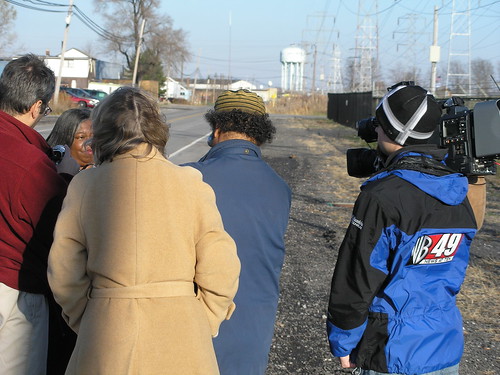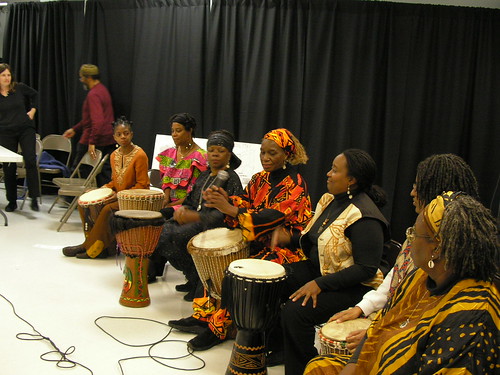An Associated Press analysis of a little-known government research project shows that black Americans are 79 percent more likely than whites to live in neighborhoods where industrial pollution is suspected of posing the greatest health danger.Click here for a whole mess of articles connected to this one. The AP articles leave you feeling pretty wrung-out. The residents inteviewed are struggling with debilitating asthma, other respiratory and pulmonary diseases that leave many unable to work or go to school, despite their desperate desire to pull themselves out of poverty. Many of these communities also suffer from suspiciously high rates of cancer and birth defects. The story is classically familar: Goliath-sized corporations with huge lobbying muscle, flouting already-weak environmental laws and poisoning communities that have little power to fight back. "Now what?" is a question that isn't eliciting many convincing answers.
Residents in neighborhoods with the highest pollution scores also tend to be poorer, less educated and more often unemployed than those elsewhere in the country, AP found.
The article I cited above includes interviews with residents of Rubbertown, an industrial area of Louisville, Kentucky, full of toxic releases and surrounded by predominantly low-income, black neighborhoods. I met some folks from Rubbertown while I was at this gathering in New York.
 We were hosted by the Citizens Environmental Coalition of Western NY, and the Lupus/Toxic Waste Coalition, more of the same kinds of people interviewed in those AP articles, low-income people of color who are breathing poisoned air and getting sick - but who are fighting it. On Saturday night, after two days of meetings where we hashed out all kinds of academic and public policy questions, we got on the bus to tour Tonawanda. Our "tour guide" was a Citizens Environmental Coalition member. As we drove along, she would point out various industrial facilities and mention the kinds of pollutants they discharge. "This is the Goodyear plant. This is the GM drive train plant. This is the wastewater treatment plant. This is the hazardous waste landfill. This is the 3M plant..." This picture is of a resident & activist from Rubbertown being interviewed by the local news station in front of a 3M plant that is spewing noxious odors and pollutants (and I mean really noxious odors) into the surrounding community.
We were hosted by the Citizens Environmental Coalition of Western NY, and the Lupus/Toxic Waste Coalition, more of the same kinds of people interviewed in those AP articles, low-income people of color who are breathing poisoned air and getting sick - but who are fighting it. On Saturday night, after two days of meetings where we hashed out all kinds of academic and public policy questions, we got on the bus to tour Tonawanda. Our "tour guide" was a Citizens Environmental Coalition member. As we drove along, she would point out various industrial facilities and mention the kinds of pollutants they discharge. "This is the Goodyear plant. This is the GM drive train plant. This is the wastewater treatment plant. This is the hazardous waste landfill. This is the 3M plant..." This picture is of a resident & activist from Rubbertown being interviewed by the local news station in front of a 3M plant that is spewing noxious odors and pollutants (and I mean really noxious odors) into the surrounding community.At this stop on the tour, we got to see some community power in action. What the AP didn't really write about was how the folks from Rubbertown aren't just sitting around with their pollution and their heart disease saying "woe is me." They are fighting. In fact, they fought so hard that Louisville, Kentucky has now intstituted the strictest air toxics programs in the nation, thanks to their efforts. Part of how they won this was with data - cold, hard data that showed they were being poisoned every time they took a breath. But they didn't rely on the factories, or the local air pollution control district, or the state, or even the EPA, to collect the data. They got it themselves, with the help of some other poisoned folks from down in Texas.
Have you heard of the Bucket Brigade? People in Cancer Alley (the stretch along the lower Mississippi loaded with chemical and petroleum refineries) would capture air samples in big plastic buckets to be tested for contaminants. Many of them used the data to win settlements for health care or to be relocated to cleaner communities. Some folks in Port Arthur, Texas won a settlement this way that they used to purchase two high-tech air monitors, that could be used to monitor real-time toxic exposures. Then they took their air monitors on the road - and one of the places they went was Rubbertown.
In Tonawanda, the fight is far from its happy ending, but I think this is the part of the story that the AP left out. The people in these communities may not have the resources or the power to stage high-profile campaigns, they may be less educated than most "environmentalists" and they may be suffering from all kinds of illnesses without adequate access to health care, but they certainly aren't resigned to this poisoned fate.
At that tour stop in Tonawanda in front of the 3M plant, we got to see community members fire up that Cerex air monitor for the first time (they got high readings for ozone and benzene, as I recall). After the tour we all gathered, with a lot of other people from the surrounding area, at a church in east Buffalo for a community meeting on environmental issues, and delicious Caribbean food prepared by the members of the Toxic Waste/Lupus Coalition. Directly across the street from the church was a large state Superfund site, the former location of a lead smelter inside the inner-city neighborhood. We heard a lot of discussion about the environmental justice issues that are high on the list for the attendees, and I think a lot of people were thinking, "now what?"
 It's a long, hard fight ahead for all these communities, for Tonawanda, for east Buffalo, for the hundreds across the nation that the AP identified in their study and many hundreds of others that the report overlooked. At the end of the gathering, a group of women called the Sisters of Creative Sound told some stories, sang and drummed for us. They said, "we're gonna send you out with a healing rhythm." Everybody danced out of the church to the drumming, bellies full of good food. I know that afterwards, everybody went back to their own neighborhoods across the country with a little more juice for the fight. I think they were all carrying that healing rhythm home with them.
It's a long, hard fight ahead for all these communities, for Tonawanda, for east Buffalo, for the hundreds across the nation that the AP identified in their study and many hundreds of others that the report overlooked. At the end of the gathering, a group of women called the Sisters of Creative Sound told some stories, sang and drummed for us. They said, "we're gonna send you out with a healing rhythm." Everybody danced out of the church to the drumming, bellies full of good food. I know that afterwards, everybody went back to their own neighborhoods across the country with a little more juice for the fight. I think they were all carrying that healing rhythm home with them.
No comments:
Post a Comment
Note: Only a member of this blog may post a comment.